Physical examination tet - Study guides, Class notes & Summaries
Looking for the best study guides, study notes and summaries about Physical examination tet? On this page you'll find 103 study documents about Physical examination tet.
All 103 results
Sort by
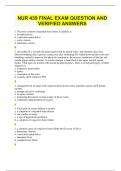
-
NR-439:| NR 439 EVIDENCE BASED PRACTICE GRADED A+ EXAM 1
- Exam (elaborations) • 46 pages • 2024
-
Available in package deal
-
- $10.00
- + learn more
NR-439:| NR 439 EVIDENCE BASED PRACTICE GRADED A+ EXAM 1 NUR 439 FINAL EXAM QUESTION AND VERIFIED ANSWERS 1. The most common congenital heart defect in children is a. tricuspid atresia b. ventricular septal defect c. aortic stenosis d. pulmonary atresia b 2. the mother of a 4 month old infant reports that he turned "blue" and seemed to have fast labored breathing after vigorous crying soon after awakening. He settled down and his color and breathing seemed to improve. On physical examinatio...
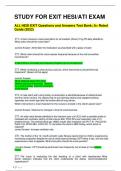
-
ALL HESI EXIT Questions and Answers Test Bank; A+ Rated Guide
- Exam (elaborations) • 117 pages • 2023
-
- $12.49
- 1x sold
- + learn more
ALL HESI EXIT Questions and Answers Test Bank; A+ Rated Guide STUDY FOR EXIT HESI/ATI EXAM ALL HESI EXIT Questions and Answers Test Bank; A+ Rated Guide (2022) 271. A client receives a new prescription for simvastatin (Zocor) 5 mg PO daily at bedtime. What action should the nurse take? (correct Answer- Administer the medication as prescribed with a glass of water 272. Which client should the nurse assess frequently because of the risk for overflow incontinence? A client Who is confused and f...
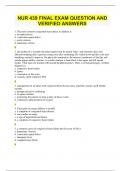
-
NUR 439 FINAL EXAM QUESTION AND VERIFIED ANSWERS 1. The most common congenital heart defect in children is a. tricuspid atresia b. ventricular septal defect c. aortic stenosis d. pulmonary atresia b 2. the mother of a 4 month old infant reports that he tu
- Exam (elaborations) • 46 pages • 2024
-
Available in package deal
-
- $11.00
- + learn more
NUR 439 FINAL EXAM QUESTION AND VERIFIED ANSWERS 1. The most common congenital heart defect in children is a. tricuspid atresia b. ventricular septal defect c. aortic stenosis d. pulmonary atresia b 2. the mother of a 4 month old infant reports that he turned "blue" and seemed to have fast labored breathing after vigorous crying soon after awakening. He settled down and his color and breathing seemed to improve. On physical examination, the mucous membranes of the lips and mouth appear mildl...
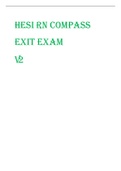
-
HESI RN COMPASS EXIT EXAM V2 2023 LATEST VERSION
- Exam (elaborations) • 20 pages • 2023
-
- $18.49
- 2x sold
- + learn more
HESI RN COMPASS EXIT EXAM V2 2023 LATEST VERSION 1. A primipara with a breech presentation is in the transition phase pf labor. The nurse visualizes the perineum and sees the umbilical cord extruding from the introitus. In which position should the nurse place the client? Supine with the foot of the bed raised 2. The nurse is developing a series of childbirth preparation classes for primigravida women and their significant others. what is the priority expected outcome for these classes?...
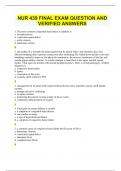
-
NUR 439 FINAL EXAM QUESTION AND VERIFIED ANSWERS
- Exam (elaborations) • 46 pages • 2024
-
Available in package deal
-
- $9.00
- + learn more
NUR 439 FINAL EXAM QUESTION AND VERIFIED ANSWERS1. The most common congenital heart defect in children is a. tricuspid atresia b. ventricular septal defect c. aortic stenosis d. pulmonary atresia b 2. the mother of a 4 month old infant reports that he turned "blue" and seemed to have fast labored breathing after vigorous crying soon after awakening. He settled down and his color and breathing seemed to improve. On physical examination, the mucous membranes of the lips and mouth appear mildly ...
![[PEDIA] Inara Long Quizzes - Questions and Answers (Complete Solutions)](/docpics/5290592/66427f93c1143_5290592_121_171.jpeg)
-
[PEDIA] Inara Long Quizzes - Questions and Answers (Complete Solutions)
- Exam (elaborations) • 57 pages • 2024
-
- $28.49
- + learn more
[PEDIA] Inara Long Quizzes - Questions and Answers (Complete Solutions) Which of the following is not part of TOF? A. Pulmonary stenosis B. Atrial septal defect C. Dextroposition of the aorta D. Right ventricular hypertrophy Which of the following is true regarding the pathophysiology of TOF? A. Pulmonary blood flow may be supplied by the patent foramen ovale B. VSD is usually restrictive and large, located below the pulmonic valve C. Aortic arch is right-sided in 50% of cases 20% of cases D. ...
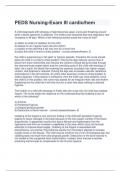
-
PEDS Nursing-Exam III cardio/hem 2023
- Exam (elaborations) • 30 pages • 2023
- Available in package deal
-
- $9.99
- + learn more
PEDS Nursing-Exam III cardio/hem A child diagnosed with tetralogy of fallot becomes upset, crying and thrashing around when a blood specimen is obtained. The child's color becomes blue and respiratory rate increases to 44 bpm. Which of the following actions would the nurse do first? a) obtain an order for sedation for the child b) assess for an irregular heart rate and rhythm c) explain to the child that it will only hurt for a short time d) place the child in knee-to-chest position - ...
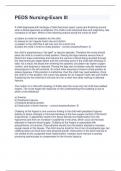
-
PEDS Nursing-Exam III questions and correct answers 2023/2024
- Exam (elaborations) • 30 pages • 2023
-
- $10.49
- + learn more
PEDS Nursing-Exam III A child diagnosed with tetralogy of fallot becomes upset, crying and thrashing around when a blood specimen is obtained. The child's color becomes blue and respiratory rate increases to 44 bpm. Which of the following actions would the nurse do first? a) obtain an order for sedation for the child b) assess for an irregular heart rate and rhythm c) explain to the child that it will only hurt for a short time d) place the child in knee-to-chest position - correct ans...
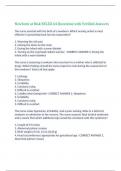
-
Newborn at Risk NCLEX 64 Questions with Verified Answers,100% CORRECT
- Exam (elaborations) • 18 pages • 2024
-
- $11.19
- + learn more
Newborn at Risk NCLEX 64 Questions with Verified Answers The nurse assisted with the birth of a newborn. Which nursing action is most effective in preventing heat loss by evaporation? 1. Warming the crib pad 2. Closing the doors to the room 3. Drying the infant with a warm blanket 4. Turning on the overhead radiant warmer - CORRECT ANSWER 3. Drying the infant with a warm blanket The nurse is assessing a newborn who was born to a mother who is addicted to drugs. Which findings should ...
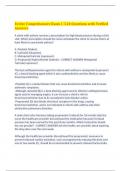
-
Evolve Comprehensive Exam 1 |124 Questions with Verified Answers,100% CORRECT
- Exam (elaborations) • 39 pages • 2023
-
- $11.49
- + learn more
Evolve Comprehensive Exam 1 |124 Questions with Verified Answers A client with asthma receives a prescription for high blood pressure during a clinic visit. Which prescription should the nurse anticipate the client to receive that is at least likely to exacerbate asthma? A. Pindolol (Visken). B. Carteolol (Ocupress). C. Metoprolol tartrate (Lopressor). D. Propranolol hydrochloride (Inderal). - CORRECT ANSWER Metoprolol Tartrate( Lopressor) The best antihypertensive agent for clien...

That summary you just bought made someone very happy. Also get paid weekly? Sell your study resources on Stuvia! Discover all about earning on Stuvia


